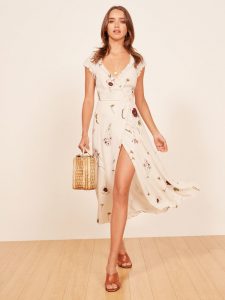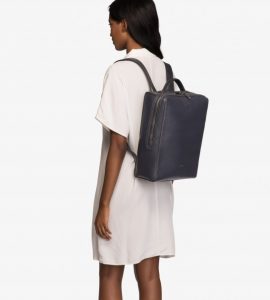Sustainable Fashion Choices
The disposable way we currently make and consume fashion is not sustainable, so Lotty has looked at what we can do as individuals to make more sustainable fashion choices…
I’m a big documentary fan and recently watched The True Cost – a Netflix documentary about the devastating effects of fast fashion. I thought I was environmentally conscious, now I’m not so sure. My wardrobe is bursting with clothes I never wear and I’m the dream subscriber for fashion or beauty related newsletters, idly clicking and impulse buying a new item I might only wear once or twice. My awareness of the term ‘fast fashion’ and the problems it creates has been around for a long time, but the harsh realities of my own shopping choices have never truly resonated with me until now.

Photo by Kai Pilger on Unsplash
After watching the likes of ‘Blue Planet II’, the Ocean Rescue series on Sky Atlantic, ‘Cowspiracy’ and Leo Dicaprio’s ‘Before The Flood’, I was horrified by the disastrous effects we as humans are having on our planet. It actually made me feel quite helpless, but in response I was quick to eat less meat, to buy a re-usable bottle and recycle as much plastic as possible. But I’m not sure I, or most people, have the same level of consciousness when it comes to what we wear.
Whilst it’s incredibly reassuring to see so many Government initiatives being put into place to reduce our plastic consumption, it’s less apparent if the effect fast fashion is having on our environment is also on the agenda. The number of cheap, ‘throw away’ clothing brands seems to be growing, not reducing. So why are we (generally) still more relaxed about fast fashion?
The severity and enormity of the situation is so far removed from what we can really comprehend, it’s difficult to see how your own actions will make any real difference. It’s easy to remain blissfully ignorant about how and where your clothes were made and where they go when you’re done with them (I read recently, the average piece of clothing is worn just 7 times before being tossed). And there are a lot of conflicting messages to combat – consumer culture and the lustful feeling of ‘newness’ do not sit well with sustainability. Perhaps, rather than us buying significantly less (which would also damage our economy), maybe brands should be sorting out the problem first.
Leaders in the fashion industry are already making some impressive moves… In 2017 the British Fashion Council launched Fashion SWITCH to Green, working with Dame Vivienne Westwood and the Mayor of London bringing the fashion industry together to lead in climate action. The British Fashion Council also continues to focus on its Positive Fashion initiative, a platform designed to celebrate industry best practice and encourage future business decisions to create positive change across three strategic pillars: Sustainability, Equality & Diversity, and Craftsmanship & Community. And lucky for us, (taking inspiration from industry influencers like the BFC and ethical high-end designers like Stella McCartney), there’s a surge in more affordable High Street brands becoming more socially conscious in the production of their clothing.
It’s promising to see fast fashion giants committing to becoming more sustainable. H&M and Zara have both launched their respective socially conscious clothing lines and ASOS has introduced the Eco Edit, where you can shop a variety of ethical brands. It’s these big High Street names making steps in the right direction that will help the fashion conscience to spread. It helps to make sustainable fashion more easily accessible to those of us who aren’t totally clued up and still really like the kick you get from a shopping spree.
So, how do you become a genuine (well-dressed) Eco Warrior?
I know I want to, I’m just figuring out exactly where to start… It takes time to change habits and requires significant willpower to fend off the sparkly new clothes being thrown around your peripherals on a daily basis. A more environmentally conscious wardrobe also often comes at a higher price too, choosing quality over quantity. But, I like to think eventually the investments will pay off, as I will have clothes that are better cut and last longer.
Here are a few ethical brands I want to wear:
M.i.h Jeans
The brand sources their fabric here in the UK to reduce their carbon footprint. And their ethical awareness doesn’t stop at their clothes. The interiors of their retail spaces are made from recycled materials, such as old denim (makes sense!). They also make really great jeans!
Reformation
Sustainability is the core value of Reformation. From materials, to store fit-outs, water usage, and waste, they are continuously trying to find better solutions for making clothes sustainably. I recently bought this dress, which came with a recycled hanger, clothing bag and reusable tote bag.
Matt and Nat
I’m yet to buy any vegan leather, but would love this backpack by Matt and Nat (MAT(T)erial & NATure). The brand is inspired by nature and is committed to not using animal leathers or any animal materials, opting for sustainable, recyclable options instead.
Arket
Not a ‘sustainable brand’ per se, but they are part of the H&M group which means they have to follow sustainability standards. Plus they are a relatively new company, so were able to make socially conscious choices in their manufacturing and material right from the start.
Other ways of maintaining a more sustainable wardrobe…
Re wear statement or ‘occasion’ pieces with different accessories
If the Duchess of Cambridge can do it with that beautiful Alexander McQueen dress and jacket, so can we! Livia Firth (Founder of Eco Age) initiated the #30wears campaign; encouraging people to question whether they will wear something at least 30 times, before they buy it. If you won’t, buy something else that you can wear again and again.
Invest in vintage or pre-owned clothing and accessories
Buy vintage and/or unwanted clothes on sites like Vestiare Collective and Depop. This works both ways – sell on the items you no longer wear. Vestiare is great for more expensive items (as they charge a higher commission) and Depop you can pretty much sell any clothes / accessories you want – I just sold a ‘vintage’ pair of Versace sunglasses I’ve had since 2006 for £40… every little helps!
When it comes to fast fashion, just like limiting plastic use, I think it’s important to be realistic about becoming entirely sustainable as an individual. It’s unlikely I will totally end my long-standing relationship with my favourite High Street brands. But, by being more thoughtful in shopping choices, we can support the brands that do choose to manufacture clothes with a social conscience. And hopefully, if we start to buy more carefully as consumers, more brands will recognise this and be forced to revolutionise.
Find out more about sustainability:
Grad Bites: Ethical Sustainable Fashion
The story behind Sancho’s – affordable, ethical, sustainable fashion
Love Food. Hate Waste
Quick ways to reduce the amount of food we throw away
Easy Ways to Save the World
A few things we can all do to start protecting the environment, without needing much time or money!
Lotty Lee
Lotty is Marketing Manager at HelloGrads
‘I use storytelling and creative strategies to help small innovative brands achieve their marketing goals’
Check out her website and blog here






Please log in or sign up to comment